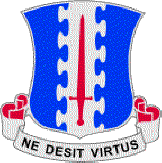Afghanistan
After the attacks on the World Trade Center and the Pentagon on 11 September 2001, the battalion once again saw active overseas service. From January to August 2002 the Leader Rakkasans deployed to Afghanistan as part of Operation Enduring Freedom, where it participated in numerous search and attacks, raids, and air assaults against the elusive remnants of the Taliban near the Pakistan border, helping to stabilize the country. For its actions, the battalion earned the Afghanistan campaign streamer.
In February 2010, the Leader Rakkasans returned to Afghanistan in support of Operation Enduring Freedom. Once arriving in Western Paktika Province the battalion partnered with the Afghan National Security Forces in securing the population. In August 2010 the battalion relocated to Andar District, Ghazni Province. At deployments end, the battalion conducted over 5,000 combat patrols and 33 air assaults. The Leader Rakkasans returned to Ft. Campbell in February 2011. For their actions from 1 April 2010 to 31 August 2010, the Leader Rakkasans were awarded the Valorous Unit Award.
From September 2012 to May 2013, the Leader Rakkasans deployed to eastern Khowst Province, Afghanistan, in support of Operation Enduring Freedom 12-13. The battalion and its combat advisor comrades partnered with a host of Afghan units to promote Afghan National Security Forces (ANSF) development, capabilities, and security. They operated alongside Afghan National Army (ANA) and Afghan National Police (ANP), helping them gain confidence in securing the population. In addition to helping the ANSF operate independently, the battalion also assisted the ANSF in disrupting the enemy's leadership and attack facilitation efforts in this challenging border region.

The 101st Airborne Division (Air Assault) ("Screaming Eagles") is a light infantry division of the United States Army that specializes in air assault operations. It can plan, coordinate, and execute multiple battalion-size air assault operations to seize terrain. These operations can be conducted by mobile teams covering large distances, fighting behind enemy lines, and working in austere environments with limited or degraded infrastructure. It was active in, for example, foreign internal defense and counterterrorism operations in Iraq, in Afghanistan in 2015–2016, and in Syria, as part of Operation Inherent Resolve in 2018–2021.

The 82nd Airborne Division is an airborne infantry division of the United States Army specializing in parachute assault operations into hostile areas with a U.S. Department of Defense mandate to be "on-call to fight any time, anywhere" at "the knife's edge of technology and readiness." Primarily based at Fort Liberty, North Carolina, the 82nd Airborne Division is part of the XVIII Airborne Corps. The 82nd Airborne Division is the U.S. Army's most strategically mobile division.

The 506th Infantry Regiment, originally designated the 506th Parachute Infantry Regiment during World War II, is an airborne light infantry regiment of the United States Army. Currently a parent regiment under the U.S. Army Regimental System, the regiment has two active battalions: the 1st Battalion, 506th Infantry Regiment is assigned to the 1st Brigade Combat Team, 101st Airborne Division, and the 2nd Battalion, 506th Infantry Regiment is assigned to the 3rd Brigade Combat Team, 101st Airborne Division.

The 187th Airborne Infantry Regiment (Rakkasans) is a regiment of the 101st Airborne Division.
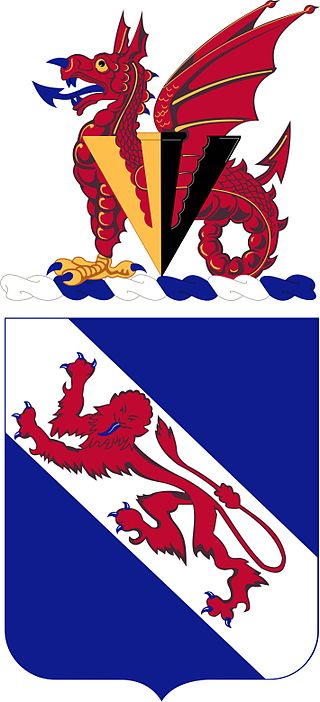
The 508th Infantry Regiment is an airborne infantry regiment of the United States Army, first formed in October 1942 during World War II. The 508th is a parent regiment under the U.S. Army Regimental System, and two battalions from the regiment are currently active: the 1st Battalion, 508th Parachute Infantry Regiment is assigned to the 3rd Brigade Combat Team, 82nd Airborne Division, and the 2nd Battalion, 508th Parachute Infantry Regiment is assigned to the 2nd Brigade Combat Team, 82nd Airborne Division. The regiment served in combat during World War II, and regimental elements have served in combat in the Dominican Republic, Vietnam, Grenada, Panama, Iraq and Afghanistan.

The 502nd Infantry Regiment, previously titled the 502nd Parachute Infantry Regiment, is an infantry regiment of the United States Army. The regiment was established shortly after U.S. entry into World War II, and was assigned as a regiment of the 101st Airborne Division, "The Screaming Eagles", one of the most decorated formations of the U.S. Army. The regiment saw substantial action in the European Theater of World War II and was inactivated in 1945, shortly after the end of the war. Reactivating in a new form in 1956, the 502nd Infantry has served in the Vietnam War, the Persian Gulf War, Iraq War, War in Afghanistan, and Operation Inherent Resolve in Iraq. Since 1974, the regiment has been classified as an Air Assault unit. Currently, its 1st and 2nd battalions are active. Both battalions are assigned to the 2nd Brigade Combat Team, 101st Airborne Division.
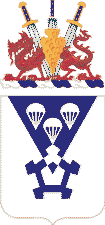
The 503rd Infantry Regiment, formerly the 503rd Parachute Infantry Regiment and the 503rd Airborne Infantry Regiment, is an airborne infantry regiment of the United States Army. The regiment served as an independent regiment in the Pacific War during World War II; at Fort Campbell, Kentucky; in Okinawa, Japan; and in Germany. Regimental elements have been assigned to the 2nd Infantry Division, the 11th Airborne Division, the 24th Infantry Division, 25th Infantry Division, the 82nd Airborne Division, 101st Airborne Division, and the 173rd Airborne Brigade Combat Team. Regimental elements have participated in campaigns in the Vietnam War, Operation Enduring Freedom–Afghanistan, and Operation Iraqi Freedom. The regiment claims 15 Medal of Honor recipients: two from World War II, ten from Vietnam, and three from Afghanistan. A parent regiment under the U.S. Army Regimental System. The regiment's 1st and 2nd Battalions are active, assigned to the 173rd Airborne Brigade, based at Caserma Ederle, Vicenza, Italy. The 3rd and 4th Battalions as well as Companies E, F, G, H, and I have been inactived.

The 2nd Ranger Battalion, currently based at Joint Base Lewis–McChord south of Seattle, Washington, United States, is the second of three ranger battalions belonging to the United States Army's 75th Ranger Regiment.

The 26th Infantry Regiment is an infantry regiment of the United States Army. Its nickname is "Blue Spaders", taken from German soldiers in World War I, seeing the spade-like device on the regiment's distinctive unit insignia, and calling those soldiers “Blauerspadern”. The 26th Infantry Regiment is part of the U.S. Army Regimental System; currently only the 1st Battalion is active and assigned to the 2nd Brigade Combat Team, 101st Airborne Division.

The 325th Infantry Regiment is an infantry regiment of the 82nd Airborne Division. The regiment serves as the 82nd Airborne's light infantry parachute insertion fighting force of the United States Army, with a long and distinguished history, having taken part in World War I, World War II, the Vietnam War, the invasions of Grenada and Panama, as well as the Gulf and Iraq Wars. The subordinate units of the regiment constitute the bulk of the infantry elements assigned to the 2nd Infantry Brigade Combat Team, 82nd Airborne Division.
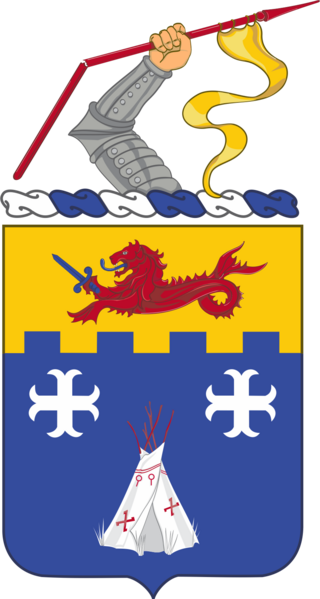
The 12th Infantry Regiment is a unit of the United States Army. The 12th Infantry has fought in seven wars from the Civil War to the Global War on Terrorism and has been awarded 19 Presidential Unit Citations, five Valorous Unit Awards, a Joint Meritorious Unit Award, two citations in the Order of the Day of the Belgian Army, Nine Republic of Vietnam Crosses of Gallantry, the Republic of Vietnam Civil Action Honor Medal Third Class, a Meritorious Unit Commendation, and the Belgian Fourragere.
The Special Troops Battalion, 3rd Brigade Combat Team, 101st Airborne Division, Fort Campbell, Kentucky, was a multi-functional battalion created on 16 September 2004 as part of the U.S. Army's brigade realignment plan to transform brigades into units of action (UA). It brought together a combat engineer company from the 326th Engineer Battalion (Combat) (Airborne) and signal and military intelligence companies formerly affiliated with inactivated battalions in the 101st Airborne Division. Although one former member of the battalion recalled that the Rakkasans were "almost like a cult in every sense," the battalion itself was largely an administrative entity rather than a cohesive operational unit. With disparate roles, its component units operated separately outside of garrison, supporting maneuver battalions or the brigade itself during training and deployments.

The 2nd Infantry Regiment is an infantry regiment in the United States Army that has served for more than two hundred years. It was constituted on 12 April 1808 as the 6th Infantry and consolidated with 4 other regiments in 1815 to form the present unit.
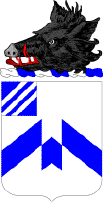
The 30th Infantry Regiment is a United States Army infantry regiment. It was originally constituted 2 February 1901 in the Regular Army as the 30th Infantry. It was organized 12 February – 19 August 1901 at Fort Logan, Colorado, at the Presidio of San Francisco, California, and in the Philippines.

The 319th Field Artillery Regiment, more commonly referred to as the 319th Airborne Field Artillery Regiment, is a parent regiment in the U.S. Army Regimental System. Four battalions of the regiment are currently active. The first three battalions 1st Battalion, 319th Field Artillery Regiment, 2nd Battalion, 319th Field Artillery Regiment, 3rd Battalion, 319th Field Artillery Regiment are in the 82nd Airborne Division and the 4th Battalion, 319th Field Artillery Regiment is in the 173rd Airborne Brigade.
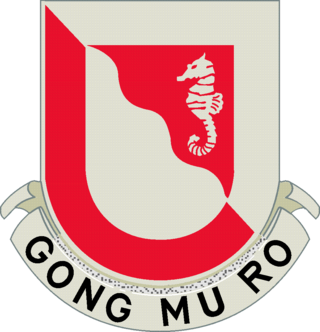
The 14th Brigade Engineer Battalion is a Combat Engineer Battalion of the United States Army based at Joint Base Lewis-McChord, Washington. The battalion is a subordinate unit of the 2nd Stryker Brigade, 2nd Infantry Division, and I Corps. The battalion's official motto is "Gong Mu Ro" and battle cry "Rugged!".

The 32nd Field Artillery Regiment is a distinguished and highly decorated field artillery regiment of the United States Army, first Constituted in 1918.
The 2nd Battalion, 319th Field Artillery Regiment is the field artillery battalion that is assigned to the 2nd Brigade Combat Team, 82nd Airborne Division. Nicknamed "Black Falcons", 2–319 AFAR has participated in battles from World War I to the current day.

The 1st Battalion, 503rd Infantry Regiment is an active duty airborne infantry battalion in the United States Army, assigned to the 173rd Airborne Brigade Combat Team and stationed in Vicenza, Italy. The battalion has served with the 2nd Infantry Division, the 11th Airborne Division, the 24th Infantry Division, the 82nd Airborne Division, and the 173rd Airborne Brigade; has been stationed in Korea, Italy and the United States; and earned campaign credits in World War II, the Vietnam War, Operation Enduring Freedom-Afghanistan, and Operation Iraqi Freedom.
The 101st Airborne Division is a specialized modular light infantry division of the US Army trained for air assault operations. The Screaming Eagles has been referred to by journalists as "the tip of the spear" as well as one of the most potent and tactically mobile of the U.S. Army's divisions. The 101st Airborne Division has a history that is nearly a century long. During World War II, it was renowned for its role in Operation Overlord, Operation Market Garden, the liberation of the Netherlands and its action during the Battle of the Bulge around the city of Bastogne, Belgium. During the Vietnam War, the 101st Airborne Division fought in several major campaigns and battles, including the Battle of Hamburger Hill in May 1969. In mid-1968, it was reorganized and redesignated as an airmobile division and then in 1974 as an air assault division. In recent years, the division has served in Iraq and Afghanistan. At the height of the War on Terror, the 101st Airborne Division had over 200 aircraft. The division now has slightly over 100 aircraft.
